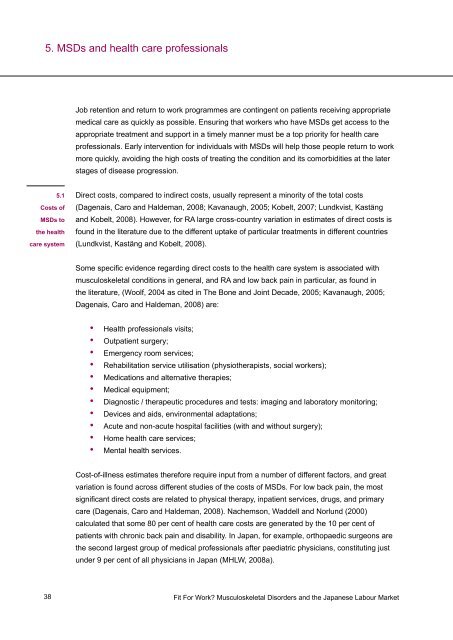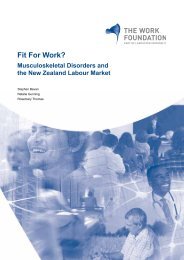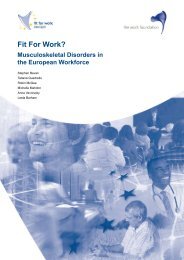English version - Fit for Work Europe
English version - Fit for Work Europe
English version - Fit for Work Europe
You also want an ePaper? Increase the reach of your titles
YUMPU automatically turns print PDFs into web optimized ePapers that Google loves.
5. MSDs and health care professionals<br />
38<br />
5.1<br />
Costs of<br />
MSDs to<br />
the health<br />
care system<br />
Job retention and return to work programmes are contingent on patients receiving appropriate<br />
medical care as quickly as possible. Ensuring that workers who have MSDs get access to the<br />
appropriate treatment and support in a timely manner must be a top priority <strong>for</strong> health care<br />
professionals. Early intervention <strong>for</strong> individuals with MSDs will help those people return to work<br />
more quickly, avoiding the high costs of treating the condition and its comorbidities at the later<br />
stages of disease progression.<br />
Direct costs, compared to indirect costs, usually represent a minority of the total costs<br />
(Dagenais, Caro and Haldeman, 2008; Kavanaugh, 2005; Kobelt, 2007; Lundkvist, Kastäng<br />
and Kobelt, 2008). However, <strong>for</strong> RA large cross-country variation in estimates of direct costs is<br />
found in the literature due to the different uptake of particular treatments in different countries<br />
(Lundkvist, Kastäng and Kobelt, 2008).<br />
Some specific evidence regarding direct costs to the health care system is associated with<br />
musculoskeletal conditions in general, and RA and low back pain in particular, as found in<br />
the literature, (Woolf, 2004 as cited in The Bone and Joint Decade, 2005; Kavanaugh, 2005;<br />
Dagenais, Caro and Haldeman, 2008) are:<br />
• Health professionals visits;<br />
• Outpatient surgery;<br />
• Emergency room services;<br />
• Rehabilitation service utilisation (physiotherapists, social workers);<br />
• Medications and alternative therapies;<br />
• Medical equipment;<br />
• Diagnostic / therapeutic procedures and tests: imaging and laboratory monitoring;<br />
• Devices and aids, environmental adaptations;<br />
• Acute and non-acute hospital facilities (with and without surgery);<br />
• Home health care services;<br />
• Mental health services.<br />
Cost-of-illness estimates there<strong>for</strong>e require input from a number of different factors, and great<br />
variation is found across different studies of the costs of MSDs. For low back pain, the most<br />
significant direct costs are related to physical therapy, inpatient services, drugs, and primary<br />
care (Dagenais, Caro and Haldeman, 2008). Nachemson, Waddell and Norlund (2000)<br />
calculated that some 80 per cent of health care costs are generated by the 10 per cent of<br />
patients with chronic back pain and disability. In Japan, <strong>for</strong> example, orthopaedic surgeons are<br />
the second largest group of medical professionals after paediatric physicians, constituting just<br />
under 9 per cent of all physicians in Japan (MHLW, 2008a).<br />
<strong>Fit</strong> For <strong>Work</strong>? Musculoskeletal Disorders and the Japanese Labour Market







